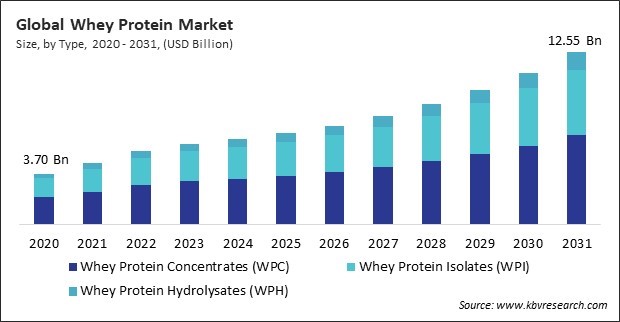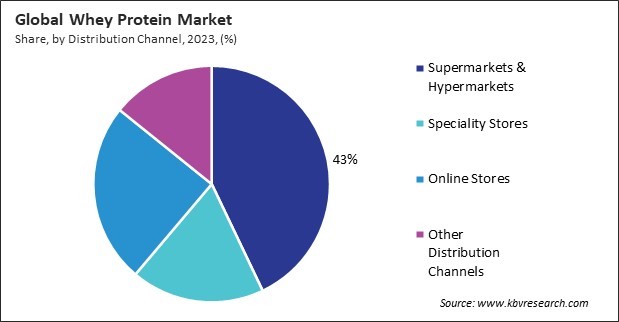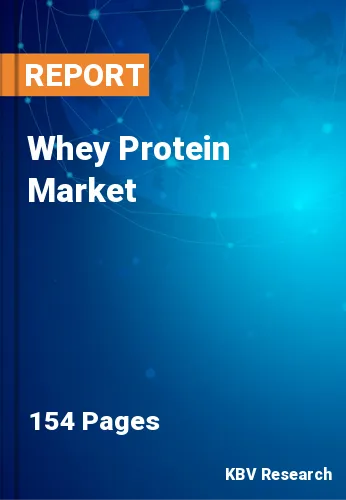“Global Whey Protein Market to reach a market value of USD 12.55 Billion by 2031 growing at a CAGR of 10.5%”
The Global Whey Protein Market size is expected to reach $12.55 billion by 2031, rising at a market growth of 10.5% CAGR during the forecast period. In the year 2023, the market attained a volume of 157,737.7 tonnes, experiencing a growth of 14.0% (2020-2023).
Whey protein is widely used in infant formula due to its similarity to breast milk protein, making it highly digestible and suitable for infants. The expansion of this segment is further bolstered by increasing birth rates in developing regions, as well as a burgeoning preference for premium, nutritionally enhanced infant formula products in developed markets. Advances in product innovation, such as hydrolyzed whey protein for infants with allergies, also expanded the segment. Thus, the infant formula segment procured 18% revenue share in the market in 2023. In terms of volume, 51,877.9 tonnes of whey protein are expected to be utilized in infant formula application by the year 2031.

Fitness enthusiasts and athletes, in particular, rely on whey protein to support their rigorous training regimens, as it provides essential amino acids required for muscle repair and growth. Beyond the fitness community, health-conscious individuals are turning to whey protein as a convenient way to meet their daily protein needs, especially amidst busy lifestyles.
Additionally, the rising incidence of lifestyle-related diseases, including obesity, diabetes, and cardiovascular disorders, has emerged as a substantial global concern. These health issues are often linked to sedentary lifestyles, poor dietary habits, and rising stress levels, prompting greater emphasis on preventive healthcare and balanced nutrition. Consequently, the growing recognition of these health advantages, coupled with intensified initiatives to address lifestyle-related maladies, has resulted in a significant increase in the demand for whey protein.
However, A substantial part of the global population is impacted by lactose intolerance, a condition characterized by the deficiency of the enzyme lactase. This enzyme is essential for lactose digestion. Similarly, milk protein allergies, although less common than lactose intolerance, also affect many people, particularly children. These conditions limit the ability of affected individuals to consume dairy-derived products, including whey protein, which is a byproduct of cheese production. Consequently, the challenge posed by lactose intolerance and milk protein allergies continues to significantly impact the growth trajectory of the whey protein market.
Based on distribution channel, the market is classified into supermarkets & hypermarkets, specialty stores, online stores, and others. The supermarkets & hypermarkets segment garnered 43% revenue share in the market in 2023. In tonnes of volume, 112,747.1 tonnes of whey protein is expected to be sold in supermarkets and hypermarkets by the year 2031. The supermarkets and hypermarkets segment benefits from its ability to offer a wide variety of whey protein products under one roof, providing convenience and accessibility to consumers.

On the basis of type, the market is divided into whey protein concentrates (WPC), whey protein isolates (WPI), and whey protein hydrolysates (WPH). The whey protein isolates (WPI) segment recorded 37% revenue share in the market in 2023. In terms of volume, 86,747.0 tonnes of whey protein isolate by the year 2031. WPIs are known for their high protein content, typically exceeding 90%, and minimal levels of fats and lactose, making them ideal for individuals with lactose intolerance or those adhering to strict dietary regimens.
By application, the market is segmented into sports nutrition, dietary supplements, infant formula, beverages, and food & feed additives. The sports nutrition segment witnessed 31% revenue share in the market in 2023. In terms of volume, 80,121.6 tonnes of whey protein is expected to be utilized in sports nutrition application by the year 2031. The expansion of the segment is owed to the rising global interest in fitness, bodybuilding, and athletic pursuits, which stimulates the demand for premium protein products that facilitate muscle recovery and enhance performance.
Free Valuable Insights: Global Whey Protein Market size to reach USD 12.55 Billion by 2031
Region-wise, the market is analyzed across North America, Europe, Asia Pacific, and LAMEA. The Europe segment recorded 31% revenue share in the market in 2023. In terms of volume, the Europe region is expected to utilize 75,063.9 tonnes of whey protein by the year 2031. Countries like Germany, the UK, and France are key contributors, driven by the growing popularity of sports nutrition and functional foods.
| Report Attribute | Details |
|---|---|
| Market size value in 2023 | USD 5.89 Billion |
| Market size forecast in 2031 | USD 12.55 Billion |
| Base Year | 2023 |
| Historical Period | 2020 to 2022 |
| Forecast Period | 2024 to 2031 |
| Revenue Growth Rate | CAGR of 10.5% from 2024 to 2031 |
| Quantitative Data | Volume in Tonnes, Revenue in USD Billion, and CAGR from 2020 to 2031 |
| Number of Pages | 366 |
| Number of Tables | 750 |
| Report coverage | Market Trends, Revenue Estimation and Forecast, Segmentation Analysis, Regional and Country Breakdown, Porter’s 5 Forces Analysis, Company Profiling, Companies Strategic Developments, SWOT Analysis, Winning Imperatives |
| Segments covered | Type, Distribution Channel, Application, Region |
| Country scope |
|
| Companies Included | Kerry Group plc., Glanbia PLC, Fonterra Co-operative Group Limited, Arla Foods Amba, Carbery Group Ltd., Lactalis Group, Maple Island, Inc., Leprino Foods Company, Agropur Dairy Cooperative (Davisco Foods International, Inc.), and NOW Foods, Inc. |
By Distribution Channel (Volume, Tonnes, USD Billion, 2020-2031)
By Type (Volume, Tonnes, USD Billion, 2020-2031)
By Application (Volume, Tonnes, USD Billion, 2020-2031)
By Geography (Volume, Tonnes, USD Billion, 2020-2031)
This Market size is expected to reach $12.55 billion by 2031.
Rising Health and Fitness Awareness are driving the Market in coming years, however, Substantial Population with Lactose Intolerance and Allergies restraints the growth of the Market.
Kerry Group plc., Glanbia PLC, Fonterra Co-operative Group Limited, Arla Foods Amba, Carbery Group Ltd., Lactalis Group, Maple Island, Inc., Leprino Foods Company, Agropur Dairy Cooperative (Davisco Foods International, Inc.), and NOW Foods, Inc.
The expected CAGR of this Market is 10.5% from 2024 to 2031.
The Whey Protein Concentrates (WPC) segment is leading the Market by Type in 2023; thereby, achieving a market value of $6.5 billion by 2031.
The North America region dominated the Market by Region in 2023, and would continue to be a dominant market till 2031; thereby, achieving a market value of $4.8 billion by 2031.
Our team of dedicated experts can provide you with attractive expansion opportunities for your business.

 Drivers
Drivers
 Restraints
Restraints
 Opportunities
Opportunities
 Challenges
Challenges
